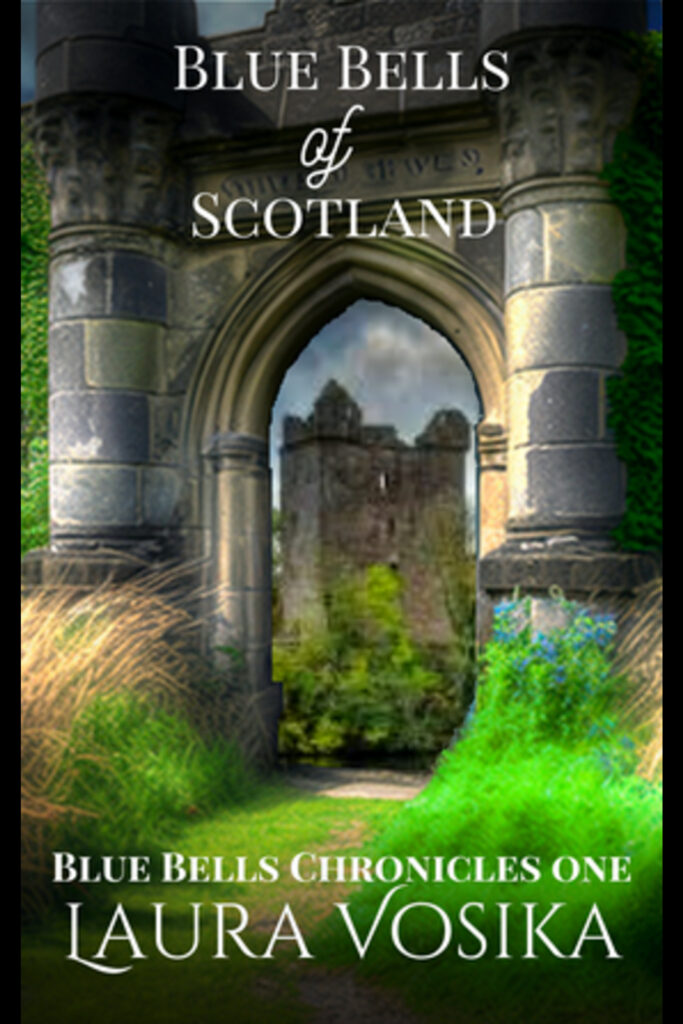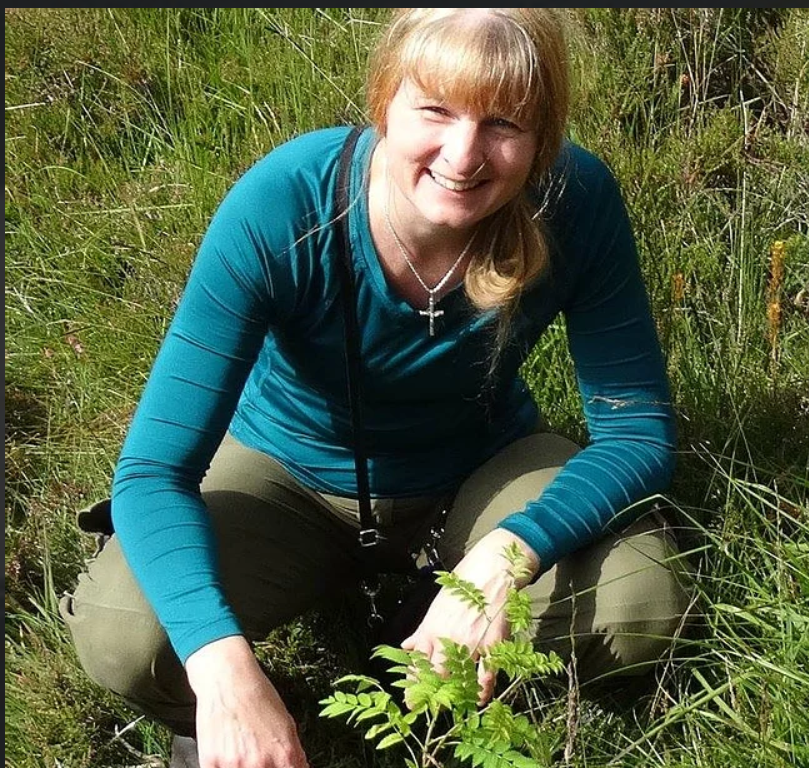

How many books have you written? Which is your favorite?
Fifteen, I think. I’ve put out the five books of the Blue Bells Chronicles–the story of an obnoxious, arrogant modern musician who finds himself caught in the time of Robert the Bruce. It’s definitely what I’m known for.
However, I’ve also written The Saint in the Cellar, with my husband Chris Powell, the story of a boy who is either very fanciful in his new St. Paul mansion–or experiencing a miracle and Things Beyond Our World which is a collection of short stories on the paranormal, including two written by me and Chris that try to explain our own paranormal experience by Roubidoux Creek in Missouri.
On the non-fiction side, I’ve put out On Wings of Love and Light, a collection of poetry and essays on the theme of love, and four other poetry anthologies; The Four Spheres, a journal for building better life habits; Go Home and Practice, a journal for better, more focused practice of a musical instrument, and Glenmirril Garden, a collection of original and traditional music in Celtic styles.
My favorite are the Blue Bells Chronicles books, very closely followed by The Saint in the Cellar.
What inspired the idea for your book? The Blue Bells Chronicles started from the fact that I played trombone semi-professionally and every trombonist who’s any good wants to play Blue Bells of Scotland. I wanted to write a book I would love to read, including about the streaming banners and noble deeds mentioned in the song. Researching a time of noble deeds in Scotland took me to the Battle of Bannockburn in 1314 and along with an image that just flashed into my mind of an arrogant, obnoxious man at a gambling table, the story of Shawn Kleiner, trapped in medieval Scotland, began to write itself.
The Saint in the Cellar is a fascinating book to me because it stemmed in part from the research I was doing into the medieval time in which Shawn found himself. Part of this research involved ‘anchorites’ who, around the 1200s, had themselves sealed into a room that had a window looking into the church so they could attend mass and another looking out to the street so they could counsel people and pray with them. They spent their entire lives in this room, devoting their time to prayer.
Chris and I were looking to buy a home at the time and toured the mansion of a railroad baron, Edgar Long, on Summit Hill in St. Paul. Going into the basement, we saw an odd little room, long and narrow, that had a window looking into a much bigger, brighter room that had been the 19th Century laundry room. Having just read about anchorites, we immediately thought of an anchorite living in this room and the little boy who moves into the house with his busy, ambitious parents, and discovers this anchorite in the basement who talks to him and listens to him.
How much research did you need to do for your book? For The Blue Bells Chronicles, I put in extensive research. I spent hundreds of hours online and have a large library of books on every aspect of Scotland and medieval life and Robert the Bruce and James Douglas, the heroes of the time. I made five research trips to Scotland, visiting, with few exceptions, the locations mentioned in my book. I climbed hills, as Shawn does in the first book, in the same style of medieval leather boots he would have worn during that hike. I have a number of medieval weapons, including a re-creation of a long sword of the time so I have some idea what it really feels like to heft such a weapon.
I studied Scottish Gaelic for several years to have a feel for what Niall, the Laird, Hugh, and Allene really spoke, and I think that matters. Each language has its own set of words that affect how we think and how we see the world.
I even have one of ‘the laird’s great hunting hounds.’ The most likely breed would have been something like the Irish Wolfhound. In November 2014, I brought Liadan home. I learned what it was to have such a big dog, I learned something about the traits of the breed, and I took her to talks I gave on medieval history, where the audience could also have some hands-on experience of the time period, including meeting Liadan (who loved the attention).
What do you do to get inside your character’s heads? I try to experience life as they do–from hiking in the boots they would have worn, to knowing the language they spoke, to studying how they would have lived, to having the dogs they had. But it’s also about individuals and human nature. I know Shawn’s world because I was an orchestral musician, like him. I’m nothing like Shawn, but I know people like him and by listening to people, I have some understanding of the various reasons people end up as they do, of what makes people tick, of why they choose the paths they do.
Sometimes, getting in their heads is about closing your eyes and imagining the scene, almost of letting them just talk and seeing where it goes. This, I think, is where the knowledge from the research feeds the intuition and imagination.
What do you think makes a good story? A good plot, something that is either adventurous or tells us something about life and human nature and ourselves–and good characters who are three dimensional and real. I personally don’t care for stories with stock characters. I want people more as they really are–with both good points and bad points. And if they’re pretty much all bad, as some people are, I want to know how they got that way. And vice versa–a character can be 99% good but I want to see some path to how they got to that point in a tough world that doesn’t always make it easy.
Do you hear from your readers much? What kinds of things do they say? I’m very pleased to say I do hear from my readers. I’ve had comments on my author page and emails and private messages. They express how much they love the books, that they’ve re-read them several times, that they want more of Shawn and Niall, that it’s their favorite series ever, that the characters are very real. They may express how much they can’t stand Shawn at first.
I know many readers find Amy, Shawn’s girlfriend, frustrating because she’s weak in the opening book. I do hope that people see how she changes as she’s no longer being gaslit by him, as she regains a sense of who she was before him and even why she continues to keep giving him the benefit of the doubt.
Which of the characters do you relate to the most and why? I think most authors have parts of themselves in many characters. I found Shawn the easiest to write. Beyond playing trombone, we’re nothing alike. But I relate to his passion for music, his love of playing, his love of performing, the sheer joy he takes in bringing happiness to others through his music. I relate to his energy.
I relate to Niall, the medieval warrior. He is the ‘good twin’ to Shawn’s ‘bad twin’ but he has his flaws, despite his aspirations to, and even his belief in his own goodness. I think most of us at some point, have to face our own faults, too, and realize we might have farther to go than we wanted to think.
I should relate to Amy the most, as I have lived her experience. She was lied to, gaslit. She began to doubt herself and become a shadow of who she had been. Yet I relate to her the least. I relate more to Christina in the fourteenth century, who was in a difficult situation, who made choices to overcome.
Do you have any suggestions to help me become a better writer? If so, what are they? My biggest suggestions are 1. Read a lot; 2. pay attention to grammar, typos, spelling, etc. 3. most importantly, find a good writers’ critique group. Pay attention to people, listen to people, listen to their stories, listen to both sides of any story and develop a strong understanding of human nature and the world around you and the different ways people view things.
If you could spend a day with another popular author, whom would you choose? I love this question because I actually did get to spend a day with Margaret Anderson, the author of my favorite childhood novel, In the Keep of Time, (which no doubt influenced my own story) and it was an absolutely wonderful day getting to know her. I’ve also gotten to do an interview with Karen Essex, the popular author of Kleopatra. If I could choose another author to spend a day with, I think I’d choose Andrew Davidson, author of The Gargoyle, which is an absolutely fascinating story of a man on the wrong track in life who ends up in a terrible car fire and while recuperating in the hospital, a woman comes to visit him, insisting that they knew each other in medieval times.
What do you like to do when you’re not writing? I live with my husband on a small farm. I care for the chickens, rabbits, and sheep and in warmer months, the garden. I spend a lot of time with the dogs–Liadan, and Zephyr, our Bernese mountain dog/Anatolian shepherd puppy who will one day be a livestock guard dog. Our goal is to build up a business here at Glenmirril Farms selling eggs and rabbit and sheep products. While I don’t have a lot of time to update it, we have a site started at Glenmirril Farms that will hopefully soon have some pictures of all the animals!
I really like studying languages. My library has languages ranging from Latin and Old English to Norwegian and German. I kept a blog on Scottish Gaelic for a long time. I’m currently working on German, Russian, and Spanish on DuoLingo.
A friend recently taught me to knit, something I never had any interest in. But she’s got me hooked…so to speak! While Chris and I watch a movie in the evening, I’m usually also doing DuoLingo or kntting.
http://www.twitter.com/gabrielshornbks
Log into Facebook
The World of the Blue Bells Trilogy bluebellstrilogy.blogspot.com
Amazon.com: Laura Vosika: books, biography, latest update
http://www.youtube.com/harpwriter
http://www.youtube.com/@booksandbrews